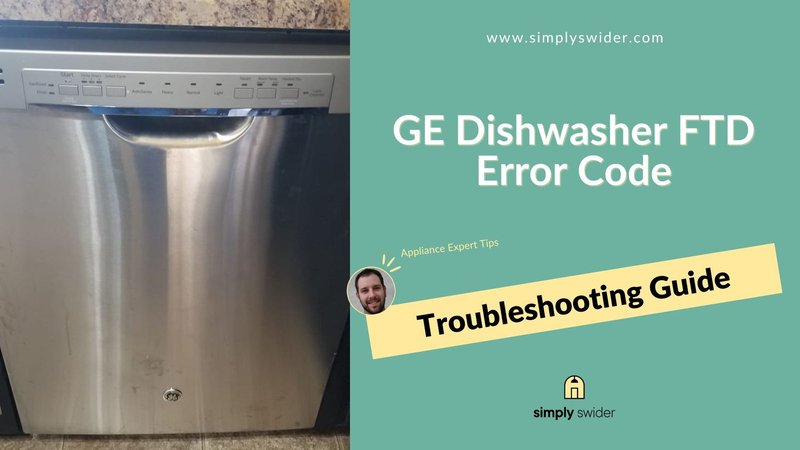
The F2 error code can be unsettling, but it’s essentially your dishwasher’s way of waving a tiny white flag and asking for help. In simple terms, this code typically points to a drainage problem. Think of it like trying to empty a bathtub with a stubbornly clogged drain. Just as the water refuses to go down, your dishwasher is having trouble getting rid of the used water. This isn’t just a minor hiccup—continuing to operate your dishwasher under these conditions could lead to bigger plumbing issues or even damage your appliance.
Understanding the Error Code F2
Before you hit the panic button and call for professional help, let’s take a closer look at what the F2 error code really means. The F2 code is an indication that your GE dishwasher is experiencing a drainage problem. Imagine trying to pour water out of a bucket with a blocked spout—that’s essentially what your dishwasher is dealing with. Water isn’t draining as it should, and it’s letting you know something is amiss.
The problem might stem from various sources—a blocked filter, a kinked drain hose, or even a malfunctioning pump. Imagine a train of dominos—if one piece falls, it sets off a chain reaction. Similarly, even a minor blockage or bend in your drain line can halt the whole operation of your dishwasher. The key here is to identify and address these small issues before they lead to bigger headaches.
Here’s where you come in. While it may seem daunting, don’t let the fear of the unknown keep you from exploring the backroads of dishwasher maintenance. A little bit of investigation can go a long way in tackling the problem swiftly. But, if the problem seems too complex, knowing when to call a professional can save you time and stress.
When to Try Fixing it Yourself
So, you’ve got the F2 error code glaring at you. Should you dive in and attempt a DIY fix, or is it time to call the pros? Sometimes, it’s worth rolling up your sleeves and giving it a shot. Think of it like a minor car problem—sometimes all you need is a little oil, and you’re good to go.
First, check the basics. Is the drain hose clogged or kinked? You might find that a simple realignment or minor unclogging job is all it takes to get things flowing again. Alternatively, the filter at the bottom of the dishwasher could be blocked with debris. With a careful hand, you can remove and clean this part, and your dishwasher might spring back to life.
However, remember, bravery in small home fixes is a virtue, but don’t let it lead you into a rabbit hole of chaos. If the problem persists despite your best efforts, it might be time to lay down the tools and pick up the phone. There’s no shame in calling for professional backup—after all, that’s what they’re here for.
Signs You Need a Technician
You’ve done everything possible, and yet, that dreaded F2 error code is as stubborn as a mule. Now’s the time to consider calling in a technician. Why? Because ignoring the problem or continuing to use the dishwasher can result in water damage or other costly repairs. Let’s break down the signs that it’s time to call in the cavalry.
If you’ve made attempts to clear any blockages and the water still won’t drain, it’s likely not just a simple clog. There could be a malfunction in the drainage pump or a more technical issue that requires expert attention. Think of a failing pump like trying to blow up a balloon with a hole in it—no matter how hard you try, the air just won’t stay in.
Another indicator for a technician visit is if you hear unusual noises coming from your dishwasher. Clanking, grinding, or hissing aren’t the kind of symphony you want your appliance to be playing. These sounds can be the harbinger of more serious mechanical problems, so let the professionals step in and diagnose the issue properly.
Ultimately, the decision to bring in a technician should come when your efforts don’t yield results, the noises raise red flags, or you simply don’t feel comfortable tackling further repairs. A professional can assess the situation and ensure that your dishwasher is back in tip-top shape without further delay.
Preventing Future F2 Errors
Now that you’ve tackled the F2 error code, let’s talk prevention. After all, an ounce of prevention is worth a pound of cure, right? Regular maintenance and a few simple habits can help keep your dishwasher running smoothly and error-free.
Make it a habit to clean your dishwasher’s filter and check the drain hose regularly. It’s like brushing your teeth—the little effort goes a long way in preventing bigger problems down the line. Also, try to scrape off large food particles from dishes before loading them into the dishwasher. Imagine trying to pour a chunky soup through a sieve—it doesn’t work so well, does it?
Lastly, consider running an empty cycle with a dishwasher cleaner now and then. It helps remove any grease and mineral buildup, keeping everything in optimal working condition. Remember, a well-maintained dishwasher is a happy dishwasher, and by taking these small steps, you’re minimizing the risk of encountering the dreaded F2 error code again.
In summary, dealing with a dishwasher error code can seem daunting, but with a bit of patience and diligence, you can often solve—or prevent—many issues yourself. And when in doubt, there’s always a technician ready to help you keep things running smoothly.